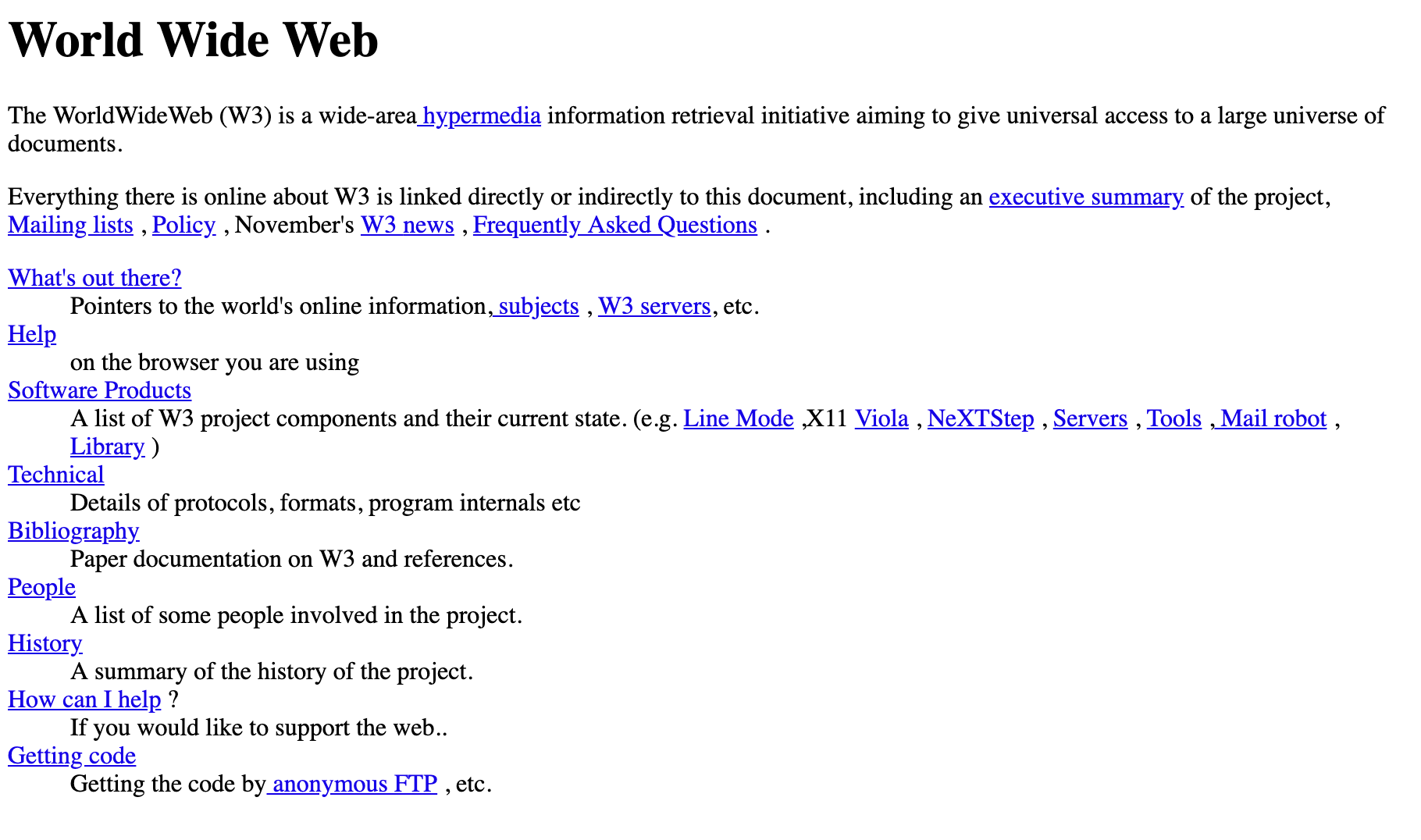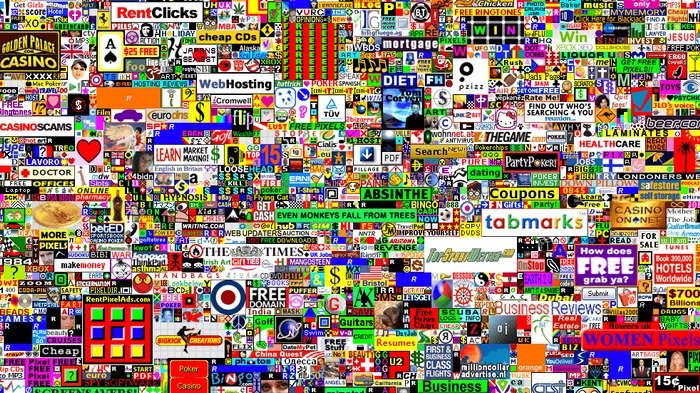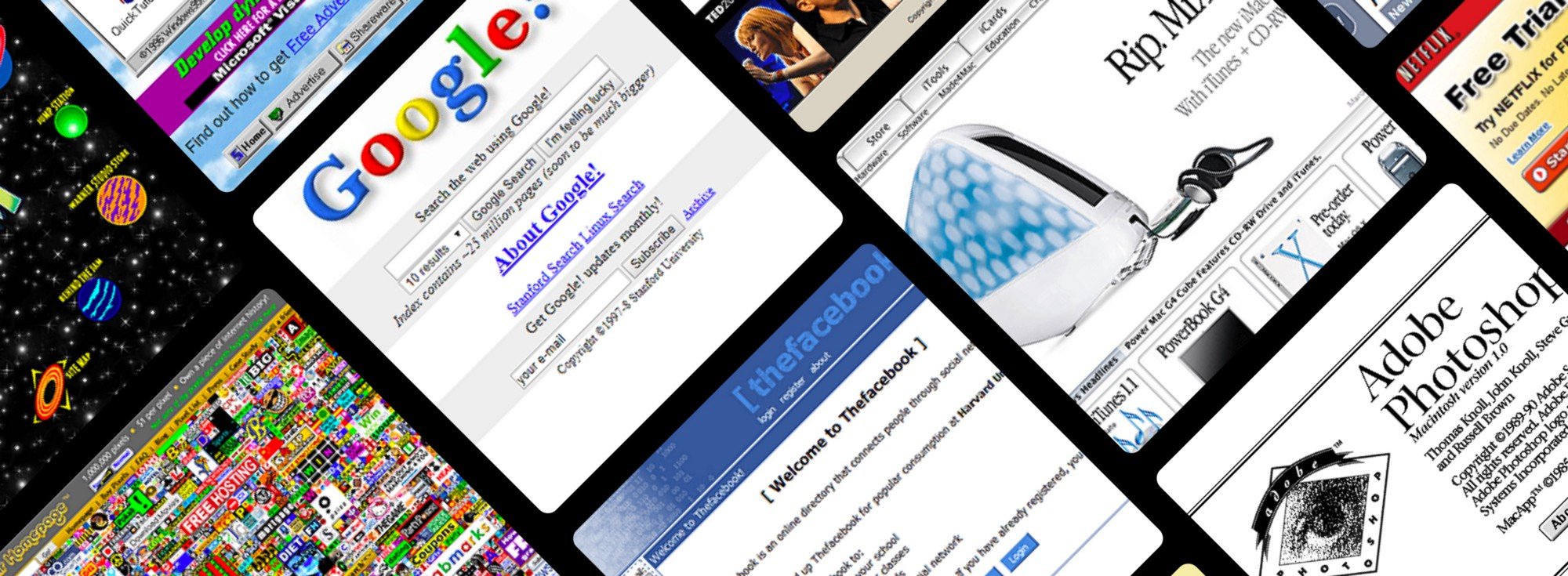The history of web design is still developing and is not so old, having its origins in the early 90's, still as a source of studies, and today it is used by the vast majority of the population as an essential part of their daily lives.
From 1991 (launching of the first site) until today, the internet has evolved at a great speed, reaching today cell phones, computers, and also objects that stay inside our homes, such as televisions, cleaning robotslight bulbs, and much more. With this the web design had to evolve and we decided to tell here a brief summary of this history that we are still building.
1990 - 1997 - The beginning of the internet age and the first websites
In August 1990 - Tim Berners-lee developed and ran the first web browser and web server, running on a NeXT computer at CERN. A copy of the first site is still available at w3.org. The site had a few links that served to explain what the internet was all about.

In 1994 the first delivery site was launched by Pizza Hut, in Santa Cruz, California, allowing pizza ordering over the internet.
Also in 1994, the World Wide Web Consortium (W3C) was formed, which began to define the standards that would be used in programming languages, and to this day is the main reference that helps in the production of new browsers and languages used, such as HTML, Javascript, etc.
In 1996 we also have the launch of one of the biggest e-commerces of today: Amazon.
Founded by Jeff Bezos, Amazon started as a large online bookstore, and gradually expanded its services to CDs, DVDs, and clothing, until it became the giant it is today.

1998 - The beginning of the era of Flash sites and Google
Discontinued today, Flash was a platform that allowed designers to incorporate music, video, and animation into websites, creating an interactive experience not previously possible. Flash marked a generation, bringing great technological innovations to the web such as interactive menus, splash pages, animations, and buttons with detailed visuals.
The internet was still new to many people and many of these elements not only served to be a decoration, but also to make the internet even more accessible, with buttons that actually resembled buttons, with interactions that kept users on the sites.
Flash's popularity has declined over the years, one of the main reasons being the amount of resources required, plus users had to have a plugin installed, which also helped spread viruses and scams.
Also in the same year Google was launched, today the largest search engine on the internet, still competing with large directories such as Altavista or Yahoo. Google emerged as a research project by Larry Page and Sergey Brin, with the intention of finding search results with the help of a mathematical algorithm. The algorithm was later called PageRank and analyzed the relationship between various pages, their content and cross-references, thus defining their relevance.

Early 2000s - Growth of websites with CSS and usability
In the year 2000, besides the famous Millennium Bug, Internet Explorer 5 was the first browser to reach about 99% of support for CSS1, which would start the generation of stylized sites that we have today (today we use CSS3 and HTML5). CSS allowed the separation of content (HTML) and design (CSS), this way it became easier to stylize a website, without having to change its structure, and the sites load faster than those made with Flash.
Also in the same year the W3C recommended the second version of Javascript, and by 2002 virtually all browsers supported the technology.
Thanks to these changes, usability started to become an even more important topic, and one of the greatest classics of usability-related literature was released by Steve Krug, the book Don't Make Me Think. Despite its almost 20 years, the original book has concepts that are still valid today, and there is an updated version for today. Both can be found by clicking on the images to the right.
Mid 2000s - Web 2.0, SEO and the Internet Revolution
Pros mid 2000s, the internet revolution began with what was called Web 2.0: websites with interactive content, social networking, immediate responses, semantics, and of course usability became even more important.
In addition to changes in aesthetics, there has been an increase in the importance of typography, the use of icons and colors, and also the beginning of the popularization of SEO (Search Engine Optimization) and the beginning of the decline of Flash.
Social sites began to be created and become popular, such as :
- MySpace - Created in 2003, it was the main social site until it started losing users to Facebook, allowing users to meet new people, keep in touch with friends.
- Youtube - Created in 2005, it was later bought by Google for $1.65 billion dollars.
- Reddit - Founded in 2005, Reddit is today one of the largest discussion group sites, the site was founded with the intention of facilitating the sharing of content, being subdivided into various topics
- Facebook, created in 2004, went public in 2006 and quickly became the largest social network.
In 2005 one of the first viral websites was created, known as A Million Dollar Homepage. The site was created by a British student, Alex Tew, and consisted of a page with a 1000x1000px grid where any user could buy the 1px space for one dollar. The smallest space allowed was 10×10 and the site reached 1 million pixels in 2006.

2010 - The beginning of the mobile era and the fall of Flash
By 2010 cell phone usage had grown to a point where approximately half of all internet access was performed as cell phones. Thus the focus on creating websites that worked on much smaller screens than desktops and with slower connections grew a lot. This was one of the causes of the beginning of the decline in the use of Flash sites, and was strengthened after the open letter from Steve JobsApple and iPhone founder, in which he talked about the disadvantages of using Flash websites. As Apple was already the market leader in mobile telephony, this letter had a big impact on the creation of websites, decreasing the popularity of Flash.
With the fall of flash came the generation of responsive websites, popular to this day, making pages accessible to all browsers with the help of CSS and Javascript to identify and configure according to the hardware that is accessing the site. The popularization became even greater with the arrival of HTML5 and CSS3.
Days of Today - performance and apartment design
The web is constantly evolving, and everything indicates that we are in yet another transition phase. Until a few years ago, even if responsive, websites were more complex, and today more and more performance has become one of the main topics, as mobile access has already passed desktop access (about 60% of website accesses are made with cell phones).
This demand is making the performance of a site even more important, being an important factor even to appear in search pages. And one design trend that is becoming closer is Flat, where you use simpler colors and elements to bring a better user experience.
Web Design History Book
The publisher Taschen in partnership with the FWA site, known for its recognition of the best sites on the Internet, has just announced the release of a book that tells the story of Web Design, or Webdesign as you prefer.
Study the past if you want to decipher the future.
Confucius
The book is a collection of examples of the evolution of the internet over the past 30 years, from its beginnings on desktops to modern days with cell phones and virtual reality. In it you can find examples of what we have today as something common, for example:
- 1st site with sound
- 1st navigation with page turning effect
- 1st site to use integrated videos
- 1st viral site
- 1st site where you could upload your photo
- 1st youtube-like site
- and much more...
There are over 200 sites, all with commentary and trivia from the creators of the sites, including Jonathan Gay (Flash), Joshua Davis (Praystation), and many other creative minds that helped shape the web as we see it today. There are 21 chapters, one for each year, detailing the user experience, usability, and milestones that influenced the development of the web to the level we have reached today.
It is worth visiting the site "The History of Web Design"to see more details.






